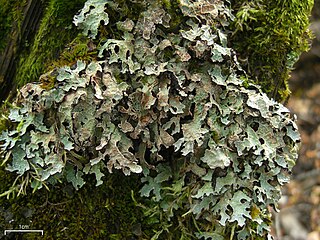
Parmelia is a genus of medium to large foliose (leafy) lichens. It has a global distribution, extending from the Arctic to the Antarctic continent but concentrated in temperate regions. There are about 40 species in Parmelia. In recent decades, the once large genus Parmelia has been divided into a number of smaller genera according to thallus morphology and phylogenetic relatedness.

The Parmeliaceae is a large and diverse family of Lecanoromycetes. With over 2700 species in 71 genera, it is the largest family of lichen-forming fungi. The most speciose genera in the family are the well-known groups: Xanthoparmelia, Usnea, Parmotrema, and Hypotrachyna.

Ahtiana is a fungal genus in the family Parmeliaceae. A monotypic genus, it contains the single species Ahtiana sphaerosporella, the mountain candlewax lichen, found in western North America. The species was originally classified as Parmelia sphaerosporella by Johannes Müller Argoviensis in 1891, before Trevor Goward established the new genus Ahtiana in 1985, naming it after Finnish lichenologist Teuvo Ahti. This foliose lichen is characterised by its pale yellowish-green thallus, spherical spores, laminal apothecia, and the presence of usnic and caperatic acids. It primarily grows on the bark of whitebark pine in subalpine and montane regions, though it occasionally colonises other conifers outside its preferred host's range.

Hypogymnia is a genus of foliose lichens in the family Parmeliaceae. They are commonly known as tube lichens, bone lichens, or pillow lichens. Most species lack rhizines that are otherwise common in members of the Parmeliaceae, and have swollen lobes that are usually hollow. Other common characteristics are relatively small spores and the presence of physodic acid and related lichen products. The lichens usually grow on the bark and wood of coniferous trees.

Myelochroa is a genus of foliose lichens in the family Parmeliaceae. They are commonly known as axil-bristle lichens. It was created in 1987 to contain species formerly placed in genus Parmelina that had a yellow-orange medulla due to the presence of secalonic acids. Characteristics of the genus include tightly attached thalli with narrow lobes, cilia on the axils, and a rhizinate black lower surface. Chemical characteristics are the production of zeorin and related triterpenoids in the medulla. Myelochroa contains about 30 species, most of which grow on bark. The genus has centres of distribution in Asia and North America.

Melanohalea is a genus of foliose lichens in the family Parmeliaceae. It contains 30 mostly Northern Hemisphere species that grow on bark or on wood. The genus is characterised by the presence of pseudocyphellae, usually on warts or on the tips of isidia, a non-pored epicortex and a medulla containing depsidones or lacking secondary metabolites. Melanohalea was circumscribed in 2004 as a segregate of the morphologically similar genus Melanelia, which was created in 1978 for certain brown Parmelia species. The methods used to estimate the evolutionary history of Melanohalea suggest that its diversification primarily occurred during the Miocene and Pliocene epochs.

Cetrelia is a genus of leafy lichens in the large family Parmeliaceae. They are commonly known as sea-storm lichens, alluding to the wavy appearance of their lobes. The name of the genus, circumscribed in 1968 by the husband and wife lichenologists William and Chicita Culberson, alludes to the former placement of these species in the genera Cetraria and Parmelia.

Parmotrema is a genus of lichen belonging to the family Parmeliaceae. It is a large genus, containing an estimated 300 species, with a centre of diversity in subtropical regions of South America and the Pacific Islands.

Punctelia is a genus of foliose lichens belonging to the large family Parmeliaceae. The genus, which contains about 50 species, was segregated from genus Parmelia in 1982. Characteristics that define Punctelia include the presence of hook-like to thread-like conidia, simple rhizines, and point-like pseudocyphellae. It is this last feature that is alluded to in the vernacular names speckled shield lichens or speckleback lichens.

Relicina is a genus of foliose lichens belonging to the large family Parmeliaceae. It contains 60 species.

Dalip Kumar Upreti is an Indian lichenologist. He served as Director and Chief Scientist at CSIR-National Botanical Research Institute, Lucknow during 1988 to 2017. Also he served as Head of Lichenology and herbarium division. Presently he is serving as CSIR-Emeritus Scientist in the same division.
Nipponoparmelia is a genus of five species of lichen belonging to the family Parmeliaceae. Nipponoparmelia was originally conceived by Syo Kurokawa as a subgenus of the genus Parmelia in 1994. It was raised to generic status in 2010. Four east Asian species were originally placed in the genus; Nipponoparmelia perplicata, found in South Korea and Russia, was added in 2014.
Emodomelanelia is a lichen genus in the family Parmeliaceae. It is monotypic, containing the single foliose Himalayan species Emodomelanelia masonii.

Notoparmelia is a genus of foliose lichens in the family Parmeliaceae. It includes 18 species that grow on bark and rocks, and are mostly distributed in the Southern Hemisphere. The genus was created in 2014 as a segregate of Parmelia.

Punctelia subflava is a species of foliose lichen in the family Parmeliaceae that occurs in Australia.

Punctelia borreri is a species of foliose lichen in the family Parmeliaceae. It is a common and widely distributed species, occurring in tropical, subtropical, and temperate regions of Africa, Asia, Europe, North America, Oceania, and South America. The lichen typically grows on bark of deciduous trees, and less commonly on rock. Some European countries have reported increases in the geographic range or regional frequency of the lichen in recent decades, attributed alternatively to a reduction of atmospheric sulphur dioxide levels or an increase in temperatures resulting from climate change.

Parmelia barrenoae is a species of foliose lichen in the large family Parmeliaceae. It was formally described as a new species in 2005. Before this, it was lumped together as one of several lichens in the Parmelia sulcata group—a species complex of genetically distinct lookalikes. Parmelia barrenoae is widely distributed, occurring in Europe, western North America, Africa, and Asia.
Parmotrema upretii is a species of saxicolous (rock-dwelling), foliose lichen in the family Parmeliaceae. Found in India, it was described as new to science in 2003 by Pradeep Divakar. The type specimen was collected near Banjar in the Kullu district of Himachal Pradesh, India at an altitude of 1,700 m (5,600 ft), where it was found growing on rock. The species epithet honours Indian lichenologist Dalip Kumar Upreti, who collected the type specimen.
Melanelia microglabra is a rare species of saxicolous (rock-dwelling) foliose lichen in the family Parmeliaceae. It is found in high-elevation locations in Sikkim, India.

Parmelia serrana is a species of foliose lichen in the family Parmeliaceae. It is native to Mediterranean regions, particularly in mountainous areas. It is a member of a complex of similar species centred around the common and widespread Parmelia saxatilis. It can be distinguished from these close relatives by the combination of long, sparsely branched lobes, numerous orbicular soralia, small pseudocyphellae, and sparse, mostly simple rhizines.














